Oregon grape Berberis × stenophylla 'Irwinii'
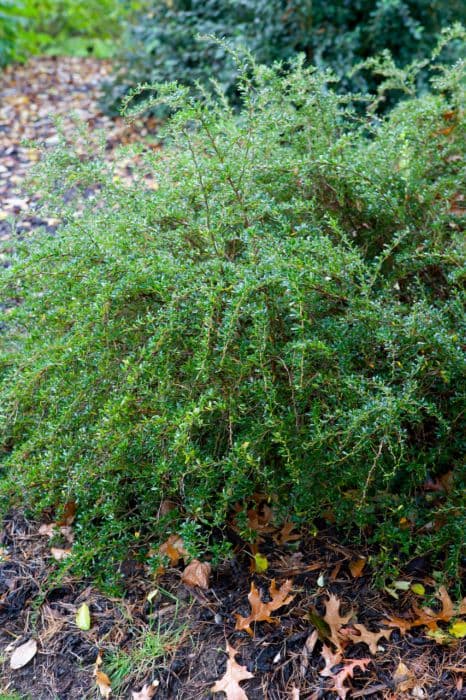
ABOUT
Berberis × stenophylla 'Irwinii', commonly known as Irwin's barberry, is an evergreen shrub with a dense and bushy appearance. The plant boasts a profusion of small, glossy, dark green leaves that are narrowly shaped, offering a sharp and spiny texture reminiscent of holly. These leaves usually grow in clusters along the arching stems, which can create an intricate interplay of light and shadow within the plant's structure. During the spring season, Irwin's barberry becomes a focal point in the garden as it produces an abundance of small, vibrant yellow flowers. These blossoms are typically bowl-shaped and are born in clusters, adding a lively burst of color against the dark foliage. The flowers not only add visual interest but also can attract various pollinators to the garden. After the flowering period, the plant may produce small, dark blue berries that stand out against the foliage. These berry-like fruits are typically oval and can add further ornamental value to the shrub as well as provide food for birds and other wildlife. Overall, Irwin's barberry presents a rich texture and color contrast throughout the year, which can be especially valuable in winter landscapes where evergreen foliage maintains visual interest even in the absence of flowers.
About this plant
 Names
NamesFamily
Berberidaceae
Synonyms
Irwin's Barberry, Narrow-Leafed Oregon Grape
Common names
Berberis × stenophylla 'Irwinii'.
 Toxicity
ToxicityTo humans
The plant commonly known as Oregon Grape may contain alkaloids, including berberine, which are considered toxic to humans if ingested in significant quantities. Symptoms of poisoning can include nausea, vomiting, diarrhea, and lethargy. It is important to avoid consuming parts of this plant, especially the roots and berries, which are more likely to contain higher concentrations of these compounds.
To pets
The Oregon Grape could also be toxic to pets if ingested, as it contains alkaloids such as berberine. In pets, symptoms of poisoning might consist of gastrointestinal upset, such as vomiting or diarrhea, as well as potential lethargy or weakness. It is advised to prevent pets from ingesting any parts of the plant to avoid these adverse effects.
 Characteristics
CharacteristicsLife cycle
Perennials
Foliage type
Evergreen
Color of leaves
Green
Flower color
Yellow
Height
5 feet [1.5 meters]
Spread
7 feet [2.1 meters]
Plant type
Shrub
Hardiness zones
7
Native area
Hybrid origin
Benefits
 General Benefits
General Benefits- Ornamental value: Berberis × stenophylla 'Irwinii', commonly known as the Oregon grape, is often appreciated for its dense, spiny foliage that produces an abundance of yellow flowers in the spring, followed by small, blue-black berries.
- Drought tolerance: The Oregon grape is known for its ability to withstand periods of drought once established, making it suitable for xeriscaping and low-water gardens.
- Erosion control: Its dense and spreading habit makes it effective at stabilizing soil on slopes and preventing erosion.
- Wildlife attraction: The Oregon grape attracts pollinators with its flowers, and the berries provide food for birds and other wildlife.
- Low maintenance: This plant generally requires minimal care once established, reducing the need for frequent watering, fertilizing, or pruning.
- Year-round interest: With evergreen foliage, it provides color and structure in the landscape throughout all seasons, especially in winter months when other plants may be dormant.
 Medical Properties
Medical PropertiesThis plant is not used for medical purposes.
 Air-purifying Qualities
Air-purifying QualitiesThis plant is not specifically known for air purifying qualities.
 Other Uses
Other Uses- Spiny Hedge: Berberis × stenophylla 'Irwinii', commonly known as Oregon grape, can be used to create a dense, spiny hedge that deters animals and intruders due to its prickly nature.
- Erosion Control: This plant's extensive root system makes it excellent for stabilizing slopes and controlling soil erosion.
- Dye Production: The bark and roots can yield a yellow dye which is useful in textile crafting and tanning.
- Winter Interest: With its evergreen leaves and sometimes persistent fruit, Oregon grape adds visual interest to gardens during the winter months.
- Photography Subject: The bright yellow flowers and blue-black berries make this plant an attractive subject for nature and garden photography.
- Themed Gardens: It can be used in native plant gardens or wildlife gardens to support local ecosystems and provide a natural appearance.
- Privacy Screen: Its dense foliage can provide privacy for garden areas or patios when grown as a screen or barrier.
- Culinary Experiments: While not commonly consumed, the sour berries can sometimes be used in small quantities to make jellies or sauces, experimenting with unique flavors.
- Foundation Planting: Due to its compact growth habit, it is suitable for planting near building foundations without the fear of root damage to structures.
- Tactile Experience: The various textures of the leaves, berries, and bark can provide a tactile experience in sensory gardens, especially for educational purposes where plant interaction is encouraged.
Interesting Facts
 Feng Shui
Feng ShuiThe Oregon grape is not used in Feng Shui practice.
 Plant Symbolism
Plant Symbolism- Protection: Barberry plants, including Berberis × stenophylla 'Irwinii', are known for their sharp thorns, which have historically been used in hedges to protect properties.
- Resilience: This plant can thrive in a wide range of conditions, symbolizing the ability to adapt and persevere through challenges.
- Vitality: With its evergreen nature and yellow flowers, it represents life and positive energy.
 Water
WaterThe Oregon grape requires moderate watering, especially during dry periods. Generally, watering once a week with about 1 to 1.5 inches of water per square foot should be sufficient. It is important to check the soil moisture; the top inch of soil should be allowed to dry out between waterings to prevent overwatering and root rot. However, during periods of extreme heat or drought, you may need to water more frequently to maintain soil moisture. Ensure that water is applied directly to the soil around the root zone rather than overhead to minimize leaf wetting and potential disease issues.
 Light
LightThe Oregon grape thrives best in full sun to partial shade. It performs well when it receives at least 6 hours of direct sunlight daily, but it can also tolerate some shade, especially in hotter climates. The ideal spot for this plant would be one where it can enjoy morning sunlight and be protected from the intense afternoon sun, or in light dappled shade underneath larger trees.
 Temperature
TemperatureThe Oregon grape is hardy and can withstand a wide range of temperatures, from about -20 to 100 degrees Fahrenheit. It can survive brief periods of colder temperatures as well, but consistently extreme cold may damage the plant. The ideal temperature range for optimal growth is between 60 and 70 degrees Fahrenheit, although it is quite adaptable and will do well in typical outdoor conditions in areas that do not experience extreme temperatures.
 Pruning
PruningPrune the Oregon grape to maintain its shape, remove any dead or diseased wood, and encourage new growth. The best time to prune this plant is in late winter or early spring before new growth begins. It can be pruned every year or every other year, depending on the plant's appearance and your desired shape. Always use clean, sharp pruning tools to make clean cuts and prevent disease transmission.
 Cleaning
CleaningNot needed
 Soil
SoilOregon Grape 'Irwinii' prefers well-draining soil with a mix of two parts loam, one part peat, and one part sand for optimal growth. The ideal soil pH should be slightly acidic to neutral, around 5.5 to 7.5.
 Repotting
RepottingOregon Grape 'Irwinii' does not require frequent repotting and can be done every 2-3 years or when the plant has outgrown its current container.
 Humidity & Misting
Humidity & MistingOregon Grape 'Irwinii' is tolerant of a wide range of humidity levels and thrives in average garden conditions without the need for specific humidity adjustments.
 Suitable locations
Suitable locationsIndoor
Ensure bright light, cool temps, and good air circulation.
Outdoor
Provide full sun to partial shade, shelter from strong winds.
Hardiness zone
6-9 USDA.
 Life cycle
Life cycleBerberis × stenophylla 'Irwinii', commonly known as Irwinii barberry, begins its life cycle as a seed, which germinates in favorable conditions of moist, well-drained soil and partial to full sun. The seedling progresses into a juvenile plant, developing a root system and foliage typical of the evergreen shrub. Over a few years, the plant reaches maturity and is characterized by its dense, spiny branches and dark, glossy leaves. During the spring, mature Irwinii barberries produce small, vibrant yellow flowers that are attractive to pollinators. After pollination, these flowers develop into dark blue, almost black berries by late summer to autumn, which are sometimes consumed by birds, enabling seed dispersal. The shrub can live for several decades, during which it may undergo periods of pruning or natural dieback, followed by regrowth, maintaining its compact and bushy appearance.
 Propogation
PropogationPropogation time
Spring-Early Summer
Berberis × stenophylla 'Irwinii', commonly known as Irwin's barberry, is typically propagated by semi-hardwood cuttings. The most appropriate time for taking cuttings is during the later part of summer, when new growth has begun to mature. To propagate, select healthy, semi-hardwood stems and cut segments about 4 to 6 inches (10 to 15 centimeters) long, ensuring each piece has several leaf nodes. The cut end of the stem should be dipped in a rooting hormone to enhance the chances of successful root development. Then, plant the cuttings in a well-draining, sterile potting mix, ensuring at least one or two nodes are buried in the soil where roots can develop. Maintaining a humid environment by covering with a plastic bag or placing in a propagator can be beneficial, as can ensuring they are in indirect light and away from extreme temperatures. Roots typically begin to form within a few weeks to a couple of months, after which the young plants can be gradually acclimatized to normal conditions and eventually transplanted outside.
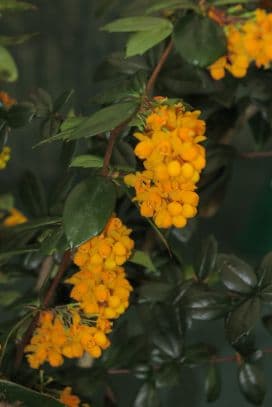
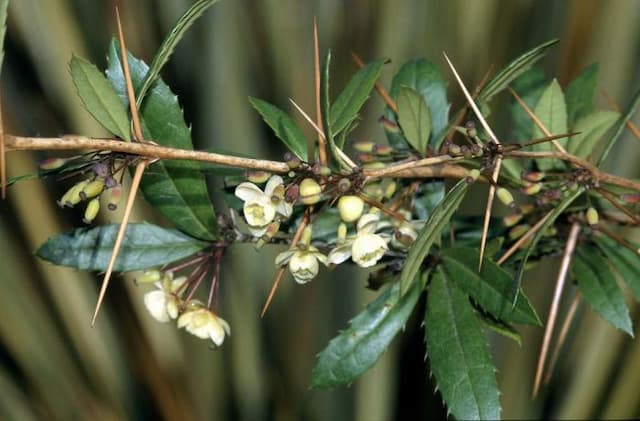
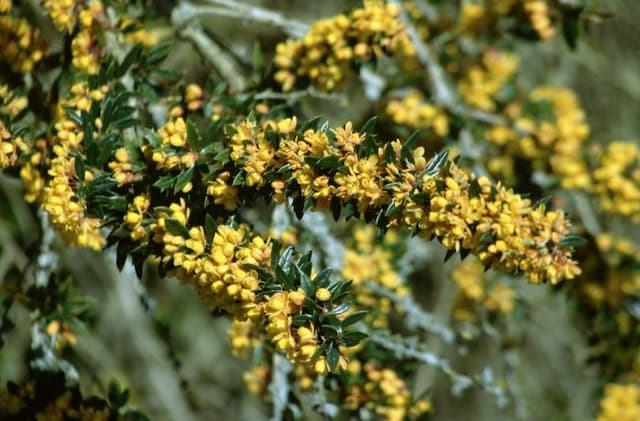
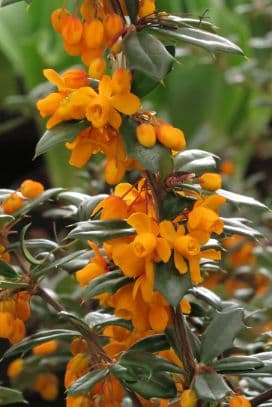


![Japanese barberry [Bonanza Gold]](/_next/image?url=https%3A%2F%2Fplants-admin.emdemapps.com%2Fimages%2Fplants%2F%2Fimages%2F604b5385e413f.png&w=640&q=75)


